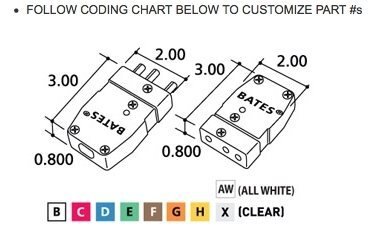BOTH company's make clear covers, but I believe Union did it first, back when they still made square bodies. I love clear covers because they let you see heat damage caused by pull outs or loose screws, before it melts a connector.
Also, there ARE ferrule crimpers, and better results are achieved by using one. Better results are also achieved by using proper gauge ferrules. I've seen more failures of 16 AWG instrument wire used in 12AWG ferrules only crimped by the screw than I can remember.
I can find almost any crimp terminal (except for flag terminals) on the shelf at Home Depot, ferrules, not so much.
Pressure plate (which, as far as I know, was Union only) has been discontinued. Union told me it just cost too much to manufacture.
My favorite 2P&G are actually the Rosco ones with the barrel springs in the female pins. [Discussion: http://www.controlbooth.com/forums/lighting-electrics/16300-never-split-pins-again.html .]
As for wire wrapping, it's a huge no no. BUT in a pinch, I'll allow it, but NOT on wires over 16 gauge. 18 AWG Zip cord used for a one time practical is the only thing I can wire wrap in good conscience. I've seen some creative wire wrapping, like splitting the strands of 12AWG in half, wrapping the two legs around a screw, twisting them back together, and then tightening the screw. Vey creative, but a practice I don't condone. Unlike solid wire, stranded jus doesn't wrap screws all that well.
Also, there ARE ferrule crimpers, and better results are achieved by using one. Better results are also achieved by using proper gauge ferrules. I've seen more failures of 16 AWG instrument wire used in 12AWG ferrules only crimped by the screw than I can remember.
I can find almost any crimp terminal (except for flag terminals) on the shelf at Home Depot, ferrules, not so much.
Pressure plate (which, as far as I know, was Union only) has been discontinued. Union told me it just cost too much to manufacture.
My favorite 2P&G are actually the Rosco ones with the barrel springs in the female pins. [Discussion: http://www.controlbooth.com/forums/lighting-electrics/16300-never-split-pins-again.html .]
As for wire wrapping, it's a huge no no. BUT in a pinch, I'll allow it, but NOT on wires over 16 gauge. 18 AWG Zip cord used for a one time practical is the only thing I can wire wrap in good conscience. I've seen some creative wire wrapping, like splitting the strands of 12AWG in half, wrapping the two legs around a screw, twisting them back together, and then tightening the screw. Vey creative, but a practice I don't condone. Unlike solid wire, stranded jus doesn't wrap screws all that well.
Last edited by a moderator:



